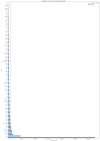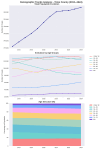Temporal Trends and Patient Stratification in Lung Cancer: A Comprehensive Clustering Analysis from Timis County, Romania
- PMID: 40723189
- PMCID: PMC12293300
- DOI: 10.3390/cancers17142305
Temporal Trends and Patient Stratification in Lung Cancer: A Comprehensive Clustering Analysis from Timis County, Romania
Abstract
Background/Objectives: Lung cancer remains a major cause of cancer-related mortality, with regional differences in incidence and patient characteristics. This study aimed to verify and quantify a perceived dramatic increase in lung cancer cases at a Romanian center, identify distinct patient phenotypes using unsupervised machine learning, and characterize contributing factors, including demographic shifts, changes in the healthcare system, and geographic patterns. Methods: A comprehensive retrospective analysis of 4206 lung cancer patients admitted between 2013 and 2024 was conducted, with detailed molecular characterization of 398 patients from 2023 to 2024. Temporal trends were analyzed using statistical methods, while k-means clustering on 761 clinical features identified patient phenotypes. The geographic distribution, smoking patterns, respiratory comorbidities, and demographic factors were systematically characterized across the identified clusters. Results: We confirmed an 80.5% increase in lung cancer admissions between pre-pandemic (2013-2020) and post-pandemic (2022-2024) periods, exceeding the 51.1% increase in total hospital admissions and aligning with national Romanian trends. Five distinct patient clusters emerged: elderly never-smokers (28.9%) with the highest metastatic rates (44.3%), heavy-smoking males (27.4%), active smokers with comprehensive molecular testing (31.7%), young mixed-gender cohort (7.3%) with balanced demographics, and extreme heavy smokers (4.8%) concentrated in rural areas (52.6%) with severe comorbidity burden. Clusters demonstrated significant differences in age (p < 0.001), smoking intensity (p < 0.001), geographic distribution (p < 0.001), as well as molecular characteristics. COPD prevalence was exceptionally high (44.8-78.9%) across clusters, while COVID-19 history remained low (3.4-8.3%), suggesting a limited direct association between the pandemic and cancer. Conclusions: This study presents the first comprehensive machine learning-based stratification of lung cancer patients in Romania, confirming genuine epidemiological increases beyond healthcare system artifacts. The identification of five clinically meaningful phenotypes-particularly rural extreme smokers and age-stratified never-smokers-demonstrates the value of unsupervised clustering for regional healthcare planning. These findings establish frameworks for targeted screening programs, personalized treatment approaches, and resource allocation strategies tailored to specific high-risk populations while highlighting the potential of artificial intelligence in identifying actionable clinical patterns for the implementation of precision medicine.
Keywords: Romania; epidemiology; lung cancer; machine learning; patient clustering; personalized medicine; temporal trends.
Conflict of interest statement
The authors declare no conflicts of interest. The funders had no role in the study’s design, in the collection, analyses, or interpretation of data, in the writing of the manuscript, or in the decision to publish the results.
Figures


















Similar articles
-
Are Current Survival Prediction Tools Useful When Treating Subsequent Skeletal-related Events From Bone Metastases?Clin Orthop Relat Res. 2024 Sep 1;482(9):1710-1721. doi: 10.1097/CORR.0000000000003030. Epub 2024 Mar 22. Clin Orthop Relat Res. 2024. PMID: 38517402
-
Association Between Comorbidity Clusters and Mortality in Patients With Cancer: Predictive Modeling Using Machine Learning Approaches of Data From the United States and Hong Kong.JMIR Cancer. 2025 Jul 16;11:e71937. doi: 10.2196/71937. JMIR Cancer. 2025. PMID: 40669089 Free PMC article.
-
[Volume and health outcomes: evidence from systematic reviews and from evaluation of Italian hospital data].Epidemiol Prev. 2013 Mar-Jun;37(2-3 Suppl 2):1-100. Epidemiol Prev. 2013. PMID: 23851286 Italian.
-
Signs and symptoms to determine if a patient presenting in primary care or hospital outpatient settings has COVID-19.Cochrane Database Syst Rev. 2022 May 20;5(5):CD013665. doi: 10.1002/14651858.CD013665.pub3. Cochrane Database Syst Rev. 2022. PMID: 35593186 Free PMC article.
-
Global epidemiological trends in prostate cancer burden: a comprehensive analysis from Global Burden of Disease Study 2021.Transl Androl Urol. 2025 May 30;14(5):1238-1252. doi: 10.21037/tau-2025-103. Epub 2025 May 27. Transl Androl Urol. 2025. PMID: 40529034 Free PMC article.
References
-
- ANALIZA-SITUATIE-CANCER-2022.pdf—Institutul Național de Sănătate Publică. 21 June 2022. [(accessed on 3 April 2025)]; Available online: https://insp.gov.ro/download/analiza-situatie-cancer-2022-pdf/
-
- [(accessed on 3 June 2023)]; Available online: https://insp.gov.ro/download/cnsisp/Fisiere-de-pe-site-CNSISP/mortalitat....
-
- Raport_ss_23_final.pdf. [(accessed on 4 July 2025)]. Available online: https://www.dsptimis.ro/promovare/raport_ss_23_final.pdf.
Grants and funding
LinkOut - more resources
Full Text Sources

